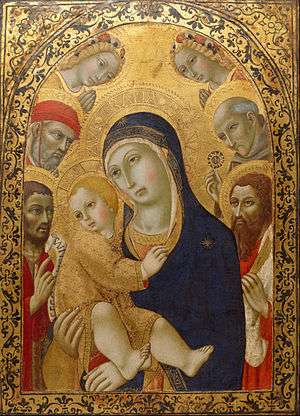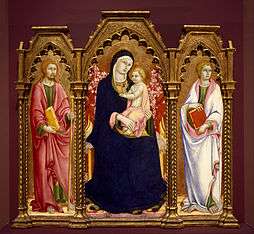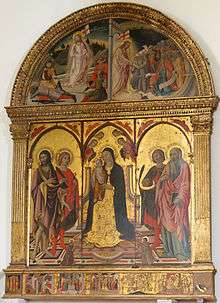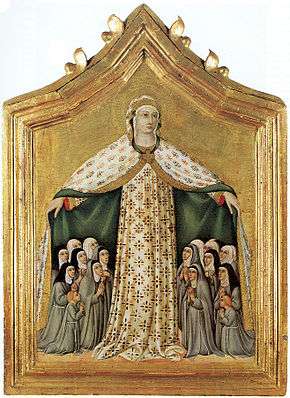Sano di Pietro
Sano di Pietro or Ansano di Pietro di Mencio (1406–1481) was an Italian painter of the Sienese school of painting. He was active for about half a century during the Quattrocento period, and his contemporaries included Giovanni di Paolo and Sassetta.

Life
Sano was born in 1406. His name enters the roll of painters in 1428 where it remained until his death in 1481.[1] In addition to his own painting and overseeing the pupils and assistants in his workshop, Sano was also part of the civic fabric of Siena, in 1431 and 1442 he was the leader of the San Donato district of Siena.[2] Sano was also employed as an arbitrator; in 1475 he was called upon to settle a dispute between fellow painters Neroccio di Bartolommeo and Francesco di Giorgio Martini.[3]
It was, however, as a painter that he made his living. The workshop he ran produced huge number of artworks. He wasn't merely a painter of altar pieces. He also produced frescoes, miniatures, and book bindings. Sano died in 1481. His death notice read;
- Pictor famosus et homo tous deditus Deo
- A famous painter and a man wholly dedicated to God[4]
The Sienese School


In the century before Sano's birth the Sienese school of painting had risen as a rival to that of the Florentines. The styles of the two schools were markedly different. Florence was said to be the more realistic of the two while Siena was said to be more fanciful. In fact the inscription above the Camopilla Gate leading into the city says;
- Cor magis tibi Siena Pandit
- Siena opens her heart still wider to thee[4]
Sienese painting was said to personify dreams. This can be seen in the hallmarks of the style of the Sienese School. Above all, the Sienese painters were known for their vibrant colors. They routinely used hues never seen in paintings before and rarely seen outside the city. They employed a richness of detail that can be quite unsettling for the first time viewer. The draperies of the clothing are elegant and numerous, but it is the patterns of the fabrics and the details on the necklines that can leave the viewer breathless. The paintings are at once sumptuous yet ethereal. This lightness of being displayed in the figures and even the landscapes themselves is the final hallmark of a painting from the Sienese School.
Reputation as a painter
In the 15th century in Siena as elsewhere in Italy and Europe the successful painter had his own workshop. In his workshop he oversaw assistants and pupils that helped him finish the commissions the painter had received. It is indicative of Sano's success that over 270 of his works survive. It is one of the paradoxes about di Pietro that because he was so successful he is often overlooked. Many of his critics say that too many of his paintings resemble each other. It is important to remember that the painter produced what the customer asked for, not what he might paint for himself. The viewer must also take note of the fact that many of these works were not produced by Sano alone. In his A History of Sienese Painting George Edgall writes:
- "It should be pointed out, however, that the monotony
- which one feels in looking at paintings labelled Sano
- di Pietro is due to the workshop assistants."[5]
In his book, Sienese Quatrocento Painting, John Pope-Hennessey furthers the argument for the quality of Sano's own paintings. He says that when the viewer looks at a painting that has been attributed solely to di Pietro one can see his sensitivity and style.
Sano's mastery of color is not in dispute. In a school of painting renowned for the use of color Sano stands out as one of the best. It isn't simply the number of color he uses, but the subtle interplay between them that makes him a master of his craft.[6] Two of his paintings show off not only his mastery of color, but also his diversity as an artist.
The first of these is a polyptych made for the Church of the Gesuati. This painting is considered by many to be di Pietro's masterpiece. It is also the first piece that can be attributed solely to him. It is a riot of color. The central figure of Mary is clad in a blue robe whose folds seem to shimmer with intensity. This intensity radiates out through the figures on either side of her. What is most impressive is how the colors play off and complement each other. This is the control of a master.
The second painting is "St. Bernardino Preaching in the Campo of Siena." In 1425 St. Bernardino gave seven sermons a day for seven weeks in the town square (campo) of Siena. Sano commemorated this event in his painting. The painting depicts a vast crowd at the center of town. The crowd is so large it seems to fall off the edge of the painting itself. The red of the clothing of St. Bernardino's audience seems to draw itself towards the pink of the building. Instead of clashing, these two colors complement each other. The warm colors are balanced by the blues in the sky and the canopy, both of which bisect the painting. It is a delicate balancing act perfectly executed.
Sano di Pietro's paintings are housed in the National Gallery and the Cathedral Museum of Siena, the Pinacoteca Vaticana, the Brooklyn Museum of Art, the Lindenau-Museum of Altenburg and the Diocesan Museum of Pienza.
Selected works
- Angel of Annunciation
 Madonna of Mercy
Madonna of Mercy Scenes from the Life of St Jerome
Scenes from the Life of St Jerome Scenes from the Life of St Jerome
Scenes from the Life of St Jerome Scenes from the Life of St Jerome
Scenes from the Life of St Jerome Nativity (c. 1445) - Panel Pinacoteca, Vatican
Nativity (c. 1445) - Panel Pinacoteca, Vatican Flight to Egypt (c. 1445) - Panel Pinacoteca, Vatican
Flight to Egypt (c. 1445) - Panel Pinacoteca, Vatican
- Christ Carrying Cross, Philadelphia Museum of Art, Philadelphia
- St Jerome (c. 1470) - Tempera on panel 95 x 51 cm. Museum of Fine Arts, Boston
- Madonna and Child - Tempera on wood, Detroit Institute of Art, Detroit
- Madonna and Christ Child with Saints - Tempera on wood, Lowe Art Museum, Coral Gables, Florida
- Virgin and Christ Child with Saints Jerome and Bernardino of Siena, Museum of Fine Arts,Houston, Texas
- Madonna and Christ Child with Saints, Denver Art Museum, Denver, Colorado
Predella of an altarpiece in five parts

 Presentation of the Virgin at the Temple (1448–52) - Tempera on wood, 32 x 46 cm. Pinacoteca, Vatican
Presentation of the Virgin at the Temple (1448–52) - Tempera on wood, 32 x 46 cm. Pinacoteca, Vatican


See also
- Domenico di Bartolo
- Master of the Osservanza
- Sassetta
- Sienese School
Citations
- Brandi, Cesare (2006). Tra Medioevo e Rinascimento: scritti sull'arte da Giotto a Jacopo della Quercia (in Italian). Editoriale Jaca Book. ISBN 9788816407367.
- van Marle, Raimond (1924). The Italian School of Painting. The Hague: Martinus Nijoff. p. 466.
- Carli, Enzo (1956). Sienese Painting. Greenwich, Conn.: New York Graphis Society. p. 56.
- Mather Jr., Frank Jewett (1962). A History of Italian Painting. New York: Holt, Rinehart and Winston. pp. 59, 94.
- George, George Harold (1932). A History of Sienese Painting. New York: L. MacVeagh. p. 211.
- Cole, Bruce (1980). Sienese Painting from its Origins to the Fifteenth Century. New York: Harper and Row. p. 207.
- "Exchange: The Nativity of the Virgin". exchange.umma.umich.edu. Retrieved 2020-03-06.
Sources
- Bernard Berenson, Essays in the Study of Sienese Painting (New York, F.F. Sherman, 1918).
- J. A. Crowe and G. B. Calvalcaselle, A History of Painting in Italy; Umbria, Florence and Siena from the Second to the Sixteenth Century (London, J. Murray, 1903).
- Timothy Hyman, Sienese Painting (New York, Thames and Hudson, 2003).
- Robert Oertel, Early Italian Painting to 1400 (New York, Frederick A. Praeger, 1968).
Further reading
- Pope-Hennessy, John & Kanter, Laurence B. (1987). The Robert Lehman Collection I, Italian Paintings. New York, Princeton: The Metropolitan Museum of Art in association with Princeton University Press. ISBN 0870994794.CS1 maint: multiple names: authors list (link) (see index; plates 59-67)
External links
| Wikimedia Commons has media related to Sano di Pietro. |